1、实验目的与要求
(1) 掌握事件处理的基本原理,理解其用途;
(2) 掌握AWT事件模型的工作机制;
(3) 掌握事件处理的基本编程模型;
(4) 了解GUI界面组件观感设置方法;
(5) 掌握WindowAdapter类、AbstractAction类的用法;
(6) 掌握GUI程序中鼠标事件处理技术。
一、理论知识
11.1 事件处理基础
⚫事件源(event source):能够产生事件的对象都可以成为事件源,如文本框、按钮等。一个事件源是一个能够注册监听器并向监听器发送事件对象的对象。
⚫ 事件监听器(event listener):事件监听器对象接收事件源发送的通告(事件对象),并对发生的事件作出响应。一个监听器对象就是一个实现了专门监听器接的类实例,该类必须实现接口中的方法,这些方法当事件发生时,被自动执行。
⚫ 事件对象(event object):Java将事件的相关信息封装在一个事件对象中,所有的事件对象都最终派生于java.util.EventObject类。不同的事件源可以产生不同类别的事件。
⚫ 监听器对象:是一个实现了特定监听器接口(listener interface)的类实例。
⚫ 事件源:是一个能够注册监听器对象并发送事件对象的对象。
⚫ 当事件发生时,事件源将事件对象自动传递给所有注册的监听器。
⚫ 监听器对象利用事件对象中的信息决定如何对事件做出响应。
⚫GUI设计中,程序员需要对组件的某种事件进行响应和处理时,必须完成两个步骤:
1)定义实现某事件监听器接口的事件监听器类,并具体化接口中声明的事件处理抽象方法。
2) 为组件注册实现了规定接口的事件监听器对象;
⚫监听器类必须实现与事件源相对应的接口,即必须提供接口中方法的实现。
11.2 动作
(1)各按钮需要同样的处理:1) 使用字符串构造按钮对象;2) 把按钮添加到面板上;
3) 用对应的颜色构造一个动作监听器;4) 注册动作监听器。
(2)动作事件:激活一个命令可以有多种方式,如用户可以通过菜单、击键或工具栏上的按钮选择特定的功能。
动作对象是一个封装下列内容的对象:
–命令的说明:一个文本字符串和一个可选图标;
–执行命令所需要的参数。
(3)Swing包提供了非常实用的机制来封装命令,并将它们连接到多个事件源,这就是Action接口。
⚫Action是一个接口,而不是一个类,实现这个接口的类必须要实现它的7个方法。
⚫ AbstractAction 类 实 现 了 Action 接 口 中 除actionPerformed方法之外的所有方法,这个类存储了所有名/值对,并管理着属性变更监听器。
11.3 鼠标事件
⚫ Swing程序默认使用Metal观感,采用两种方式改变观感。
第一种:在Java安装的子目录jre/lib下的文件swing.properties中,将属性swing.defaultlaf设置为所希望的观感类名。
第二种:调用静态的UIManager.setLookAndFeel方法,动态地改变观感,提供所想要的观感类名,再调用静态方法SwingUtilities.updateComponentTreeUI来刷新全部的组件集。
⚫ 用户点击鼠标按钮时,会调用三个监听器方法:
– 鼠标第一次被按下时调用mousePressed方法;
– 鼠标被释放时调用mouseReleased方法;
– 两个动作完成之后,调用mouseClicked方法。
⚫ 鼠标在组件上移动时,会调用mouseMoved方法。
⚫ 如果鼠标在移动的时候还按下了鼠标,则会调用
mouseDragged方法。
⚫ 监听鼠标点击事件,实现MouseListener接口:
实现mousePressed方法:- 判断鼠标点击的地方是否在小方块内;
- 如果不在小方块内,在点击的地方画一个小方块。
⚫ 实现mouseClicked方法:
- 判断鼠标点击的地方是否在小方块内;- 如果在小方块内,判断点击了几次,如果大于两次
将该方块移除。
11.4 11.4AWT 事件继承层次
(1)适配器类:鉴于代码简化的要求,对于有不止一个方法的AWT监听器接口都有一个实现了它的所有方法,但却不做任何工作的适配器类。
⚫ 当程序用户试图关闭一个框架窗口时,Jframe对象就是WindowEvent的事件源。
⚫ 捕获窗口事件的监听器:WindowListener listener=…..; frame.addWindowListener(listener);
⚫ 窗口监听器必须是实现WindowListener接口的 类的一个对象,WindowListener接口中有七个方法,它们的名字是自解释的。
⚫ 适配器类动态地满足了Java中实现监视器类的技术要求。
⚫ 通过扩展适配器类来实现窗口事件需要的动作。
(2)扩展WindowAdapter类,继承六个空方法,并覆盖WindowClosing()方法:
class Terminator extends WindowAdapter
{
public void windowClosing(WindowEvent e)
{
System.exit(0);
}
}
(3)注册事件监听器:
⚫ 可将一个Terminator对象注册为事件监听器:
WindowListener listener=new Terminator();
frame.addWindowListener(listener);
⚫ 只要框架产生一个窗口事件,该事件就会传递给监听器对象。
(4)用匿名类简化
⚫ AWT将事件分为低级(low-level)事件和语义
(semantic)事件。
–语义事件:表达用户动作的事件。
例:点击按钮(ActionEvent)。
–低级事件:形成语义事件的事件。
2、实验内容和步骤
实验1: 导入第11章示例程序,测试程序并进行代码注释。
测试程序1:
在elipse IDE中调试运行教材443页-444页程序11-1,结合程序运行结果理解程序;
(1)在事件处理相关代码处添加注释;
(2)用lambda表达式简化程序;
(3)掌握JButton组件的基本API;
(4)掌握Java中事件处理的基本编程模型
package button; import java.awt.*; import java.awt.event.*; import javax.swing.*; /** * A frame with a button panel */ public class ButtonFrame extends JFrame {//定义三个属性 private JPanel buttonPanel; private static final int DEFAULT_WIDTH = 300;//定义像素值 private static final int DEFAULT_HEIGHT = 200; public ButtonFrame() { setSize(DEFAULT_WIDTH, DEFAULT_HEIGHT);//构造器决定GUI界面的初始形状 // create buttons //创建按钮 JButton yellowButton = new JButton("Yellow"); JButton blueButton = new JButton("Blue"); JButton redButton = new JButton("Red"); buttonPanel = new JPanel(); // add buttons to panel //调用add方法,添加了三个按钮组件 buttonPanel.add(yellowButton); buttonPanel.add(blueButton); buttonPanel.add(redButton); // add panel to frame add(buttonPanel);//add方法是JFrame的方法 // create button actions //生成三个类对象,类名为ColorAction ColorAction yellowAction = new ColorAction(Color.YELLOW); ColorAction blueAction = new ColorAction(Color.BLUE); ColorAction redAction = new ColorAction(Color.RED); // associate actions with buttons //用addActionListener来对组件注册 yellowButton.addActionListener(yellowAction); blueButton.addActionListener(blueAction); redButton.addActionListener(redAction); } /** * An action listener that sets the panel's background color. */ private class ColorAction implements ActionListener//监听器类对象 { private Color backgroundColor; public ColorAction(Color c) { backgroundColor = c; } public void actionPerformed(ActionEvent event)//用actionPerformed方法让面板监听这些按钮 { buttonPanel.setBackground(backgroundColor); } } }
package button; import java.awt.*; import javax.swing.*; /** * @version 1.34 2015-06-12 * @author Cay Horstmann */ public class ButtonTest { public static void main(String[] args) { EventQueue.invokeLater(() -> { JFrame frame = new ButtonFrame();//生成ButtonFrame类的GUI界面对象 frame.setTitle("ButtonTest");//Title设置 frame.setDefaultCloseOperation(JFrame.EXIT_ON_CLOSE);//关闭界面的按钮操作 frame.setVisible(true);//可见的 }); } }
(2)用lambda表达式简化程序
package button; import java.awt.*; import java.awt.event.*; import javax.swing.*; /** * A frame with a button panel */ public class ButtonFrame extends JFrame {// 定义三个属性 private JPanel buttonPanel; private static final int DEFAULT_WIDTH = 300;// 定义像素值 private static final int DEFAULT_HEIGHT = 200; public ButtonFrame() { setSize(DEFAULT_WIDTH, DEFAULT_HEIGHT);//构造器决定GUI界面的初始形状 // create buttons //创建按钮 /*JButton yellowButton = new JButton("Yellow"); JButton blueButton = new JButton("Blue"); JButton redButton = new JButton("Red");*/ buttonPanel = new JPanel(); // add buttons to panel /*buttonPanel.add(yellowButton); buttonPanel.add(blueButton); buttonPanel.add(redButton);*/ // add panel to frame add(buttonPanel);//add方法是JFrame的方法 // create button actions //生成三个类对象,类名为ColorAction /*ColorAction yellowAction = new ColorAction(Color.YELLOW); ColorAction blueAction = new ColorAction(Color.BLUE); ColorAction redAction = new ColorAction(Color.RED);*/ // associate actions with buttons /*//用addActionListener来对组件注册 yellowButton.addActionListener(yellowAction); blueButton.addActionListener(blueAction); redButton.addActionListener(redAction);*/ makeButton("Yellow",Color.yellow); makeButton("blue",Color.blue); makeButton("red",Color.red);} public void makeButton(String name, Color backgroundColor) { JButton button = new JButton(name); buttonPanel.add(button); ColorAction action = new ColorAction(backgroundColor); button.addActionListener(action); } /** * An action listener that sets the panel's background color. */ private class ColorAction implements ActionListener// 监听器类对象 { private Color backgroundColor; public ColorAction(Color c) { backgroundColor = c; } public void actionPerformed(ActionEvent event)// 用actionPerformed方法让面板监听这些按钮 { buttonPanel.setBackground(backgroundColor); } } }
结果如下: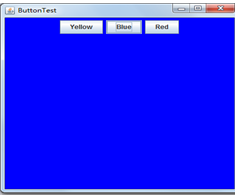
测试程序2:
l 在elipse IDE中调试运行教材449页程序11-2,结合程序运行结果理解程序;
l 在组件观感设置代码处添加注释;
l 了解GUI程序中观感的设置方法。
package plaf; import javax.swing.JButton; import javax.swing.JFrame; import javax.swing.JPanel; import javax.swing.SwingUtilities; import javax.swing.UIManager; /** * A frame with a button panel for changing look-and-feel */ public class PlafFrame extends JFrame//PlafFrame类继承JFrame类 { private JPanel buttonPanel; public PlafFrame() { buttonPanel = new JPanel();// UIManager.LookAndFeelInfo[] infos = UIManager.getInstalledLookAndFeels(); //调用此方法来列举安装的所有观感实现 for (UIManager.LookAndFeelInfo info : infos)//设置图形界面外观 makeButton(info.getName(), info.getClassName()); add(buttonPanel); pack(); } /** * Makes a button to change the pluggable look-and-feel. * @param name the button name * @param className the name of the look-and-feel class */ private void makeButton(String name, String className) { // add button to panel //在面板上添加新的按钮 JButton button = new JButton(name); buttonPanel.add(button);//调用add方法 // set button action设置按钮动作 button.addActionListener(event -> { // button action: switch to the new look-and-feel try//抛出异常 { UIManager.setLookAndFeel(className);//设置图形界面类名 SwingUtilities.updateComponentTreeUI(this);//this指示外围的对象 pack(); } catch (Exception e) { e.printStackTrace(); } }); } }
package plaf; import java.awt.*; import javax.swing.*; /** * @version 1.32 2015-06-12 * @author Cay Horstmann */ public class PlafTest { public static void main(String[] args) { EventQueue.invokeLater(() -> { JFrame frame = new PlafFrame();//生成新的类 frame.setTitle("PlafTest"); frame.setDefaultCloseOperation(JFrame.EXIT_ON_CLOSE);//关闭界面的按钮操作 frame.setVisible(true);//使结果为可见的 }); } }
结果如下:
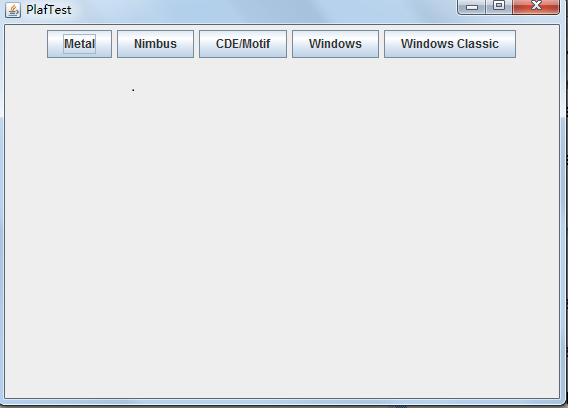
测试程序3:
l 在elipse IDE中调试运行教材457页-458页程序11-3,结合程序运行结果理解程序;
l 掌握AbstractAction类及其动作对象;
掌握GUI程序中按钮、键盘动作映射到动作对象的方法。

package action; import java.awt.*; import java.awt.event.*; import javax.swing.*; /** * A frame with a panel that demonstrates color change actions. */ public class ActionFrame extends JFrame {// 定义三个属性 private JPanel buttonPanel; private static final int DEFAULT_WIDTH = 300; private static final int DEFAULT_HEIGHT = 200; public ActionFrame() { setSize(DEFAULT_WIDTH, DEFAULT_HEIGHT);//构造器决定GUI界面的初始形状 buttonPanel = new JPanel();// 将类的实例域中的JPanel面板对象实例化 // define actions //创建了ColorAction类的三个对象 Action yellowAction = new ColorAction("Yellow", new ImageIcon("yellow-ball.gif"), Color.YELLOW); Action blueAction = new ColorAction("Blue", new ImageIcon("blue-ball.gif"), Color.BLUE); Action redAction = new ColorAction("Red", new ImageIcon("red-ball.gif"), Color.RED); // add buttons for these actions buttonPanel.add(new JButton(yellowAction));// 创建一个按钮,其属性从所提供的 Action中获取 buttonPanel.add(new JButton(blueAction)); buttonPanel.add(new JButton(redAction)); // add panel to frame add(buttonPanel); //将这个添加好按钮的面板添加到原框架中 // associate the Y, B, and R keys with names InputMap imap = buttonPanel.getInputMap(JComponent.WHEN_ANCESTOR_OF_FOCUSED_COMPONENT); // 将这个添加好按钮的面板添加到原框架中 imap.put(KeyStroke.getKeyStroke("ctrl Y"), "panel.yellow"); // 在imap中通过调用击键类KeyStroke的静态方法设置击键输入ctrl+Y的组合 imap.put(KeyStroke.getKeyStroke("ctrl B"), "panel.blue"); imap.put(KeyStroke.getKeyStroke("ctrl R"), "panel.red"); // associate the names with actions ActionMap amap = buttonPanel.getActionMap();// 用JPanel中的getACtionMap方法获得amap对象 amap.put("panel.yellow", yellowAction); amap.put("panel.blue", blueAction); amap.put("panel.red", redAction); } public class ColorAction extends AbstractAction { /** * Constructs a color action. * @param name the name to show on the button * @param icon the icon to display on the button * @param c the background color */ public ColorAction(String name, Icon icon, Color c) { putValue(Action.NAME, name); putValue(Action.SMALL_ICON, icon); putValue(Action.SHORT_DESCRIPTION, "Set panel color to " + name.toLowerCase()); putValue("color", c); //在构造器中设置一些键值对映射,这些设置的属性将会被JPanel读取 } public void actionPerformed(ActionEvent event) { Color c = (Color) getValue("color"); buttonPanel.setBackground(c);// 调用setBackground方法,设置背景颜色 } } }

package action; import java.awt.*; import javax.swing.*; /** * @version 1.34 2015-06-12 * @author Cay Horstmann */ public class ActionTest { public static void main(String[] args) { EventQueue.invokeLater(() -> { JFrame frame = new ActionFrame(); frame.setTitle("ActionTest"); frame.setDefaultCloseOperation(JFrame.EXIT_ON_CLOSE); frame.setVisible(true); }); } }
结果如下:
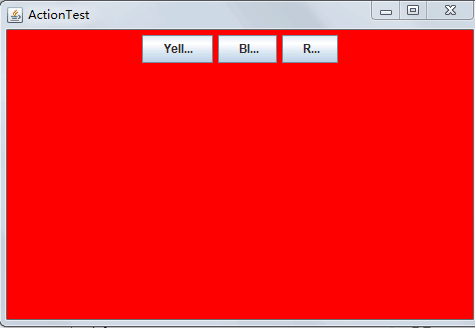
测试程序4:
l 在elipse IDE中调试运行教材462页程序11-4、11-5,结合程序运行结果理解程序;
掌握GUI程序中鼠标事件处理技术

package mouse; import java.awt.*; import java.awt.event.*; import java.awt.geom.*; import java.util.*; import javax.swing.*; /** * A component with mouse operations for adding and removing squares. */ public class MouseComponent extends JComponent {// 定义两个属性 private static final int DEFAULT_WIDTH = 300; private static final int DEFAULT_HEIGHT = 200; private static final int SIDELENGTH = 10; private ArrayList<Rectangle2D> squares;// 声明一个正方形集合 private Rectangle2D current; // the square containing the mouse cursor //用来描述矩形的类 public MouseComponent() { squares = new ArrayList<>(); current = null; // 添加两个实现的类,这两个类分别继承了监测鼠标点击情况的MouseListener和MouseMotionHandler addMouseListener(new MouseHandler()); addMouseMotionListener(new MouseMotionHandler()); } public Dimension getPreferredSize() { return new Dimension(DEFAULT_WIDTH, DEFAULT_HEIGHT); } public void paintComponent(Graphics g) { Graphics2D g2 = (Graphics2D) g; // 转换类型 // draw all squares for (Rectangle2D r : squares) g2.draw(r); // 对数组中的每个正方形,都进行绘制 } /** * Finds the first square containing a point. * @param p a point * @return the first square that contains p */ public Rectangle2D find(Point2D p) { for (Rectangle2D r : squares) { if (r.contains(p)) return r; //contains方法测定坐标是否在图形的边界内 } return null; } /** * Adds a square to the collection. * @param p the center of the square */ public void add(Point2D p) { double x = p.getX(); double y = p.getY(); //获取x和y的坐标 current = new Rectangle2D.Double(x - SIDELENGTH / 2, y - SIDELENGTH / 2, SIDELENGTH, SIDELENGTH);//用获得的坐标和既定的边长构建一个新的正方形,并将其赋值给current squares.add(current); repaint(); } /** * Removes a square from the collection. * @param s the square to remove */ public void remove(Rectangle2D s) { if (s == null) return; if (s == current) current = null; squares.remove(s); repaint();//重绘图像 } private class MouseHandler extends MouseAdapter { public void mousePressed(MouseEvent event) { // add a new square if the cursor isn't inside a square current = find(event.getPoint());// 将鼠标单击的这个点的坐标的对象赋给current if (current == null) add(event.getPoint());//在这个点绘制正方形 } public void mouseClicked(MouseEvent event) { // remove the current square if double clicked current = find(event.getPoint());// 将鼠标单击的这个点的坐标的对象赋给current if (current != null && event.getClickCount() >= 2) remove(current); } } private class MouseMotionHandler implements MouseMotionListener { public void mouseMoved(MouseEvent event) { // set the mouse cursor to cross hairs if it is inside // a rectangle if (find(event.getPoint()) == null) setCursor(Cursor.getDefaultCursor()); else setCursor(Cursor.getPredefinedCursor(Cursor.CROSSHAIR_CURSOR)); //将光标的图像设置为默认的图像 } public void mouseDragged(MouseEvent event) { if (current != null) { int x = event.getX(); int y = event.getY(); // drag the current rectangle to center it at (x, y) current.setFrame(x - SIDELENGTH / 2, y - SIDELENGTH / 2, SIDELENGTH, SIDELENGTH); //进行图形绘制 repaint(); } } } }

package mouse; import javax.swing.*; /** * A frame containing a panel for testing mouse operations */ public class MouseFrame extends JFrame { public MouseFrame() { add(new MouseComponent());//向框架中添加一个JComponent的实例 pack(); } }

package mouse; import java.awt.*; import javax.swing.*; /** * @version 1.34 2015-06-12 * @author Cay Horstmann */ public class MouseTest { public static void main(String[] args) { EventQueue.invokeLater(() -> { JFrame frame = new MouseFrame(); frame.setTitle("MouseTest");//Title设置 frame.setDefaultCloseOperation(JFrame.EXIT_ON_CLOSE);//关闭界面的按钮操作 frame.setVisible(true);//使结果为可见的 }); } }
结果如下:
实验2:结对编程练习
利用班级名单文件、文本框和按钮组件,设计一个有如下界面(图1)的点名器,要求用户点击开始按钮后在文本输入框随机显示2017级网络与信息安全班同学姓名,如图2所示,点击停止按钮后,文本输入框不再变换同学姓名,此同学则是被点到的同学姓名。

port java.awt.BorderLayout; import java.awt.Color; import java.awt.Container; import java.awt.event.ActionEvent; import java.awt.event.ActionListener; import java.util.Random; import javax.swing.JButton; import javax.swing.JFrame; import javax.swing.JLabel; import javax.swing.SwingConstants; public class RandomName { //主面板 JFrame rFrame=new JFrame("随机点名器"); //名字 String[] stuName={"杨蓉庆","张燕","杨玲","徐思","杨其菊","常慧琢","王燕","小明","小红","小花","小白","白玛次仁","陈亚茹","达拉草","狄慧","冯志霞","孔维莹"} //用于存储名字的标签 JLabel name = new JLabel(); //按钮 JButton btn = new JButton("开始点名"); Random rd = new Random(); public void init() { //提示标签页面 JLabel jt= new JLabel("随机点名器"); //设置标签居中 jt.setHorizontalAlignment(SwingConstants.CENTER); //设置字体大小 jt.setFont(new java.awt.Font("随机点名器",1,35)); //设置名字显示的标签居中 name.setHorizontalAlignment(SwingConstants.CENTER); //通过匿名类实现Action按钮的监听事件 btn.addActionListener(new ActionListener() { @Override public void actionPerformed(ActionEvent e) { // TODO Auto-generated method stub //获取随机的姓名 String n=getRandomName(); //设置name标签的文字 name.setText(n); //设置字体 name.setFont(new java.awt.Font(n,1,35)); //设置字体颜色 name.setForeground(Color.red); } }); //获取JFrame的面板 Container p = this.rFrame.getContentPane(); //设置布局方式,我采用的BorderLayout布局 p.setLayout(new BorderLayout(3,1)); //添加提示标签在北方 p.add(jt,BorderLayout.NORTH); //添加姓名标签在中央 p.add(name,BorderLayout.CENTER); //添加按钮控件在南方 p.add(btn,BorderLayout.SOUTH); //调整大小,这个是java中无法设置标签的大小 rFrame.pack(); //设置窗体大小 rFrame.setSize(300, 300); //设置可以显示 rFrame.setVisible(true); } //获取随机的姓名 public String getRandomName() { int a = 0; //random类去实现随机数时,只能设置上限,也就是说随机数产生的都是0-stuName.length之间的数字 a = rd.nextInt(stuName.length); //rd.setSeed(); //a = (int)Math.random()*stuName.length; return stuName[a]; } public static void main(String[] args) { RandomName rn=new RandomName(); rn.init(); } }
结果如下:
点名器启动界面

点名器点名界面
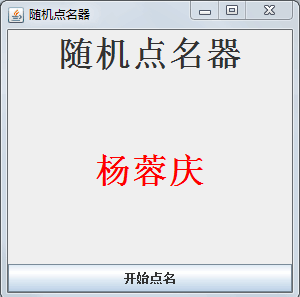
2、代码如下:
package 点名器; import java.awt.EventQueue; import javax.swing.JFrame; /** * @version 1.34 2015-05-12 * @author Cay Horstmann */ public class Demo { public static void main(String[] args) { EventQueue.invokeLater(() -> { JFrame frame = new ButtonFrame(); frame.setTitle("ButtonTest"); frame.setDefaultCloseOperation(JFrame.EXIT_ON_CLOSE); frame.setVisible(true); }); } }
package 点名器; import java.awt.Color; import java.awt.event.ActionEvent; import java.awt.event.ActionListener; import java.io.BufferedReader; import java.io.File; import java.io.FileInputStream; import java.io.FileNotFoundException; import java.io.IOException; import java.io.InputStreamReader; import java.nio.file.Path; import java.nio.file.Paths; import java.util.ArrayList; import java.util.Collections; import java.util.List; import java.util.Scanner; import java.util.Timer; import java.util.TimerTask; import javax.swing.JButton; import javax.swing.JFrame; import javax.swing.JLabel; import javax.swing.JPanel; /** * A frame with a button panel */ public class ButtonFrame extends JFrame { private JPanel buttonPanel;//定义窗格对象 private static final int DEFAULT_WIDTH = 300 * 2;//窗格宽度 private static final int DEFAULT_HEIGHT = 200 * 2;//窗格高度 private ArrayList<String> arrayList; public ButtonFrame() { setSize(DEFAULT_WIDTH, DEFAULT_HEIGHT); buttonPanel = new JPanel(); buttonPanel.setLayout(null); JLabel jLabel = new JLabel("点名器"); JButton jButton = new JButton("开始"); jLabel.setBounds(250, 80, 100, 60);//位置 jButton.setBounds(250, 150, 100, 60);//位置 arrayList = new ArrayList<>(); File file = new File("E:/学生.txt");//读取文件 FileInputStream fis; try { fis = new FileInputStream(file); InputStreamReader in = new InputStreamReader(fis); BufferedReader buf = new BufferedReader(in); String readLine; while ((readLine = buf.readLine()) != null) { arrayList.add(readLine); } } catch (FileNotFoundException e1) { // TODO Auto-generated catch block e1.printStackTrace(); } catch (IOException e1) { // TODO Auto-generated catch block e1.printStackTrace(); } jButton.addActionListener(new ActionListener() { Timer timer; public void actionPerformed(ActionEvent e) { //如果按钮显示为开始开始运行,停止后按钮显示为停止 if (jButton.getText().equals("开始")) { timer = new Timer(); TimerTask timerTask = new TimerTask() { public void run() { jButton.setText("停止"); jLabel.setText(arrayList.get((int) (Math.random() * 42))); } }; timer.schedule(timerTask, 0, 15); } if (jButton.getText().equals("停止")) { timer.cancel(); jButton.setText("开始"); } } }); jButton.setBackground(Color.orange);//按钮背景为橙色 buttonPanel.add(jLabel); buttonPanel.add(jButton); add(buttonPanel); } }
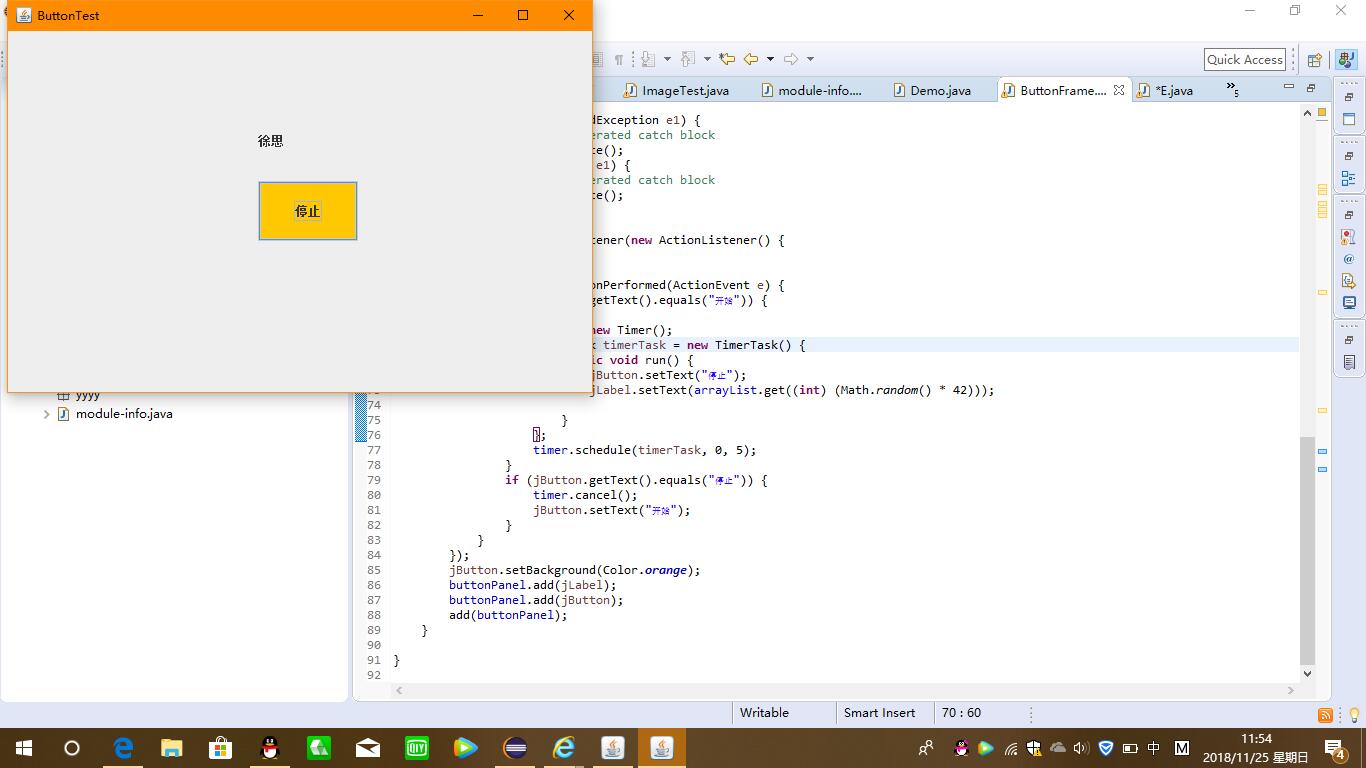
三,总结
本章我们学习了图形界面事件处理技术的知识,首先掌握了事件处理的基本原理,理解其用途;简单学会了事件处理的基本编程模型;上课在老师的演示代码过程中,我清楚的学习到了lambda表达式的简便性,简化代码的好处和代码的多变性,在实验中,通过助教学长的演示和在书上源代码基础上进行的改编,添加,做出了点名器的代码程序,感觉又是一次充实的实验。

